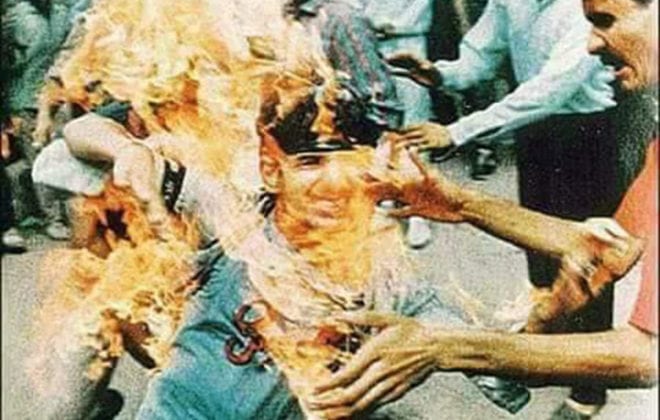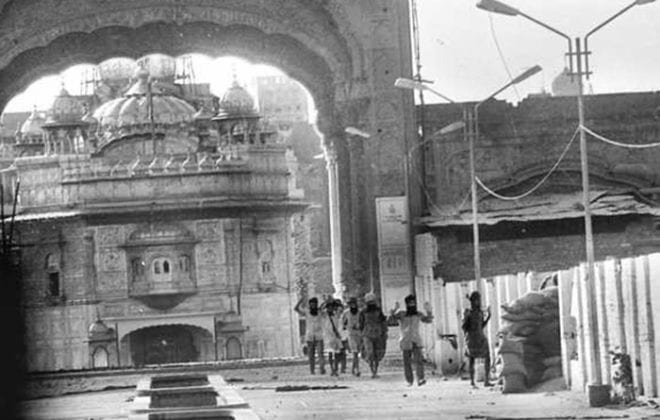1986 January – Sarbat Khalsa
Sarbat Khalsa – 26th January 1986
After 2 years of unrelenting warfare between the combined armed forces of India and the Sikh Panth, the minority Sikhs had taken the upper-hand and already succeeded in ground-breaking actions to establish autonomous rule in stronghold areas of Punjab. In desperate attempts to regain an element of fear and suppress the enrolment of Sikh youth into freedom fighting groups, the police force stamped a curfew throughout Punjab and amplified the number of innocent Sikhs they were pulling from their homes and banishing to torture centres. No man woman or child was spared. The butchers wanted to break the back-bone of the movement which was the increasing support of Sikh family homes.
Scores of CRPF units were being deployed in hotspots of the state. At a time when the leaders of freedom fighting groups were expected to go underground, they instead showcased a display of unity and strength that was un-matched through the history of modern-day revolutions. On 26th January 1986, the Sarbat Khalsa gathering of 100,000s Sikhs at the sacred Sri Akaal Takht Sahib was a slap in the face of India amidst celebrations of its 36thRepublic day (Passing of first Independent Constitution).
Before this event that solidified the sovereignty and power of the Sikh struggle for freedom, Sikh leaders had deliberated over the Gurmat agenda for many days in deep thought and lengthy debates. After careful consideration they were published with the help of Sikh journalist, Dalbir Singh Patarkar. The Akali Dal members were incensed by this proposition due to their allegiance with the central government. Each resolution from the agenda was presented to the congregation backed with an insight to how this demand would help the Sikh nation establish Khalistan, and each resolution was greeted with a roar of acceptance through bellowing slogans of ‘Bole So Nihal Sat Sri Akaal’.
Despite many attempts to sabotage Sarbat Khalsa, the Smagam opened as per Gurmat Maryada with Ardas to Sri Guru Granth Sahib Ji Maharaj for their blessing and assistance. After this the gathered Sikh nation was taken through glorious Sikh history, the greatness of the Khalsa and all the hardships we had overcome as a Panth. The Sikhs in attendance were reminded of the great sacrifice of Sri Guru Arjan Dev Ji Maharaj, who introduced martyrdom to the Sikh faith, and how Sri Guru Hargobind Sahib Ji Maharaj redefined the identity of a Gursikh to be armed, leading us to victory in 4 battles and commanded Sikhs to display the qualities of a Saint Soldier, which was maintained by Sri Guru Har Rai Sahib Ji Maharaj, Sri Guru Harkrishan Sahib Ji Maharaj and Sri Guru Tegh Bahadur Sahib Ji Maharaj, before Sri Guru Gobind Singh Ji Maharaj formalised the Khalsa Panth and blessed us with the Nishan Sahib and Nagare of Khalsa Rule.
A total of 23 official Gurmat resolutions were passed including the disbandment of the SGPC (Shiromani Gurdwara Parbandhak Committee) which was heavily influenced by Akali Dal politicians. Bhai Jasbir Singh Rode was appointed as Sri Akaal Takht Sahib Jathedar, with Jathedar Gurdev Singh Kaunke being instilled as vice. The Takht Sri Kesgarh Sahib and Takht Sri Damdama Sahib Jathedars were replaced as well as the head Granthis of Sri Harmandir Sahib.
The creation of the 1stPanthic Committee bestowed the power of being the supreme Sikh authority in any matter of polity to the following 5 members; Giani Aroor Singh, Jathedar Baba Gurbachan Singh Manochahal, Bhai Gurdev Singh Usmanwala, Bhai Dhanna Singh and Bhai Wassan Singh Zaffarwal, who announced that Sri Akaal Takht Sahib was to be re-built purely from Sikh resources. He also announced that the building work started by government money accepted through Baba Santa Singh Nihang (leader of Budha Dal Nihang Dal) and Akali Dal, was to be reversed. Baba Santa Singh was exiled from the Sikh Panth and his role as the Jathedar of Budha Dal Nihang Dal was given to Bhai Amrik Singh Jaura.
This display of sovereignty shook Delhi to its core and any suspected agents who had worked themselves into Sikh institutions were highlighted and ousted from any position of power. Those who had colluded with the central government and been identified as working against the formation of Khalistan were named and shamed. The 5-member committee proclaimed to follow the teachings of Sri Guru Gobind Singh Ji Maharaj.
POOJA AKAAL KI, PARCHA SHABAD KA, DIDAR KHALSE DE
(Worship the One True Lord, Use Gurbani as guidance, see the Guru through the Khalsa)
The Sikh Sangat was encouraged to remember that they had been duped with false promises of equality and freedom since 1947, when the majority Hindu population got its full independence with the support of Sikh martyrs and immediately after began to dilute Sikh institutions, for easier control and suppression. Furthermore, the State of Punjab was never given autonomy of its own electricity or water. Even the right to primarily teach its own language over Hindi had been revoked by Delhi, and countless indiscriminate killings of Sikhs outlined the lack of basic human rights that Sarbat Khalsa was going to fight to get back.
In 1978, Sant Jarnail Singh Ji Khalsa Bhindranwale started the Dharam Yudh Morcha to claim Sikh Human Rights pursuing the Anandpur Sahib resolutions. However, since then SGPC and Akali Dal conspired against Sant Ji and the Sikh nation to help facilitate the Sri Darbar Sahib attack so they could take sides with Delhi government and safeguard their own positions of power to remain intact. Damdami Taksal and All India Sikh Student Federation continued to campaign for freedom and had many members attain martyrdom. These groups kept allegiance to the Sikh Panth and were heavily involved in Sarbat Khalsa to help consolidate the fight for freedom and Khalistan.
As the program proceeded, prestigious accolades of honour and commemoration were bestowed on all the great martyrs of the struggle to date and their families. The title of ‘Kaumi Shaheed’ was appointed to Bhai Amrik Singh, Baba Thara Singh, General Shabeg Singh, Bhai Rashpal Singh PA, Bhai Beant Singh Maloya and Bhai Satwant Singh Agwan, Bibi Upkar Kaur as well as every other Gursikh who had sacrificed their head for the Sikh Panth so far.
After honouring countless martyrs, the traitors who had committed Panthic suicide by soliciting the Rajiv-Longowal Accord were then identified as, Harchand Singh Longowal, Gurcharan Singh Tohra, Prakash Singh Badal, Surjit Singh Barnala, Balwant Singh (RG Accord), Sukhjinder Singh, Balwant Singh Ramuwalia, and Ravinder Singh. Giani Kirpal Singh and Baba Santa Singh Nihang were also proclaimed traitors of the Sikh Panth and full control of Sri Akaal Takht Sahib was reclaimed.
The Jathedars of freedom fighting groups declared the armed struggle for freedom will continue until Khalistan has been established. They pleaded the Sikh Panth to work together for the goal of Khalistan and to never settle for anything short of complete independence. The Committee further proclaimed; that no other faith group is an enemy but anyone who chooses to help the government of Delhi in oppressing Sikh freedom, will have to pay the price. They implored that the Sikh Panth welcomes any foreign Sikhs wanting to get back to their homeland, and committed to working with Sikhs abroad who wanted to help in the fight for freedom.
Further Gurmat resolutions stamped the right for every Sikh to be armed and worship their weapons. The precedent was set to never accept a penny given by the Indian government, which was murdering and raping Sikhs daily, then trying to hide its crimes and put forward money out of falsehood. Damdami Taksal under the guidance of Baba Thakur Singh were tasked with rebuilding Sri Akaal Takht Sahib and given a fund to arrange the Kar Sewa along with other Saints. Baba Thakur Singh appealed to all practising Gursikhs who were steadfast in their Rehat and earned an honest living to come forward and help in the Sewa. Only those were allowed to partake in the Sewa who had kept respect of their Kes (unshorn hair) and were free of any intoxicants. This ruling was in accordance with the Maryada of the initial construction of Sri Akaal Takht Sahib during the reign of Sri Guru Hargobind Sahib Ji Maharaj, as Baba Budha Ji and Bhai Gurdas Ji instructed to not let anyone who has done Beadbi of their Kes and does not follow the lifestyle of a Gursikh to even touch any materials that will be used in construction.
The Panthic Committee then issued a warning to the oppressive regime, that they should reverse their sentencing of Bhai Satwant Singh Agwan and Bhai Kehar Singh or bear the brunt of the Khalsa. They appealed to all those who could contribute, to help secure the release of these heroes of the Sikh Panth, along with Bhai Parminder Singh, Bhai Harminder, and Bhai Dalip Singh arrested in the hijacking case, who were being held in Pakistan. The Sikh diaspora who had assisted in the struggle for Khalistan was thanked and praised. The whole Sikh nation was encouraged to work together as a united front regardless of their group affiliation, and again the diaspora was welcomed to come home to Punjab and dedicate its resources and efforts to achieve the goal of freedom.
The penultimate announcement was a summary of evidence that had been presented to Amnesty International and other foreign bodies Human Rights Commissions to make the demand for Khalistan and Sikh justice global. Vaisakhi and Diwali were announced as the next two occasions to hold Sarbat Khalsa as the fight for freedom continued and further issues would need addressing and Gurmat resolutions passed. Before the final Ardas, the newly appointed Panthic Jathedars declared that any Sikhs who sacrifice their life in the battle for Khalistan will forever be commemorated as Kaumi Shaheeds (Martyrs of the faith). Because of the magnitude and success of Sarbat Khalsa, 1986 already seemed like the pinnacle of the Khalistan movement. However, true to the words of Generals of the armed struggle made on that day, the armed movement picked up even greater momentum and support. The excommunication of corrupt leadership from central Sikh institutions served a major blow to police intelligence who were unable to predict the movements of top Sikh freedom fighters.
Kaumi Daastan – Bhai Narain Singh Chaura














































